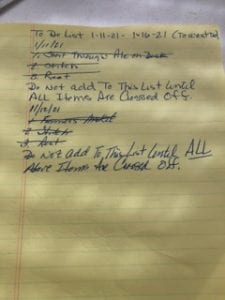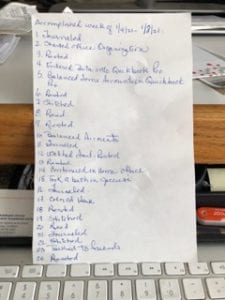List Making and Chronic Illness — How I’ve Finally Learned to Turn My Daily List-Making Habit From “Foe” to “Friend”
By Trina O’Quinn for the NABBW:

Trina O’Quinn
I have always been a list maker. That is how I, as a dyslexic, had learned to accomplish the things that had to be done. I would start my day by listing what I needed to accomplish. Then come the weekend, I would list what I wanted to accomplish in two days instead of one, so the list got longer.
I would place my list on the dining room table and cross off each item as I accomplished it. My list was always so long that looking at it, one would never think I had accomplished much in a day.
On a good day or two, the most I could accomplish would have been 4-5 things. And by day’s end, I would be exhausted beyond description.
To make it worse, I would continually add to the same list. One day, my husband asked me what I was trying to accomplish with this punch list. I responded that it was my core punch list.
His comment was: “It is too long and unreasonable for the timeframe in which you want to do it. One item on this list will take you at least a week to complete. But the longest amount of time you are giving yourself is two days. I am glad I don’t work for you.”
He was correct. No wonder I never thought I got anything done.

Here are two days worth of my lists, now using my new, shorter To Do list, where Rest is one of the listed tasks.
As I aged and my chronic illness became worse, I would push myself until I was down for the count. My lists were still 10-20 items long, depending if it was a weekday or weekend list.
Then, two years ago, I closed my private therapy practice and became 100% retired. I was no longer working and trying to keep a home. I stopped making lists and my self-talk became loud and critical. “You need to be doing something. Nothing is getting done.”
My self-criticism and nagging went on and on. So once again I began making to do lists and the fatigue cycle began once again.
Recently something happened that gave me new insight into myself. I wrote a blog on chronic illness. As would happen many times when I was an active therapist, in reading it I finally heard how I was guiding others and finally took my own advice.
I took a good long look at my actions and decided I expected too much of myself, especially in retirement. So I asked myself should I even think about writing a to do list?
Then, I heard my husband’s voice from decades past: “Make it more realistic and make sure it includes rest. Keep it small and finish what is on it before adding new items.”
This gave me food for thought. I did what I always do when I need to gain more insight. I picked up my journal and started to write. My first sentence was “How can I make a ‘to do’ list and not overwhelm myself?”
This is what appeared on the page:
- Keep the list to a maximum of 3 items.
- After the last item write DO NOT ADD TO THIS LIST UNTIL ALL ITEMS ARE CROSSED OFF!
- Include ‘rest’ as an item each day.
Then, I decided to keep an additional list, a weekly accomplishment list of everything I completed each week. I start it on Monday and review it the following Sunday.

A recent accomplishment list. Note how long it is!
The first week I did this extra list, I discovered I accomplished 28 items the first week. Not only that, I felt rested and productive. And best of all, I discovered that I had actually accomplished more than I thought I would.
These days, my list is divided into “Need To Do” and “Want To Do” items.
And you might be surprised to hear that I now make sure that “rest” and “fun” show up on the Need To Do list every day.
- To clarify, “Need To Do” items are ones that have to be done in a certain time frame. Whereas my “Want To Do” items are tasks that can float through the list and be done on a day where I am feeling that I have more energy and time.
An example of a “Want To Do” item would be giving myself a “free day.” When I’m enjoying a free day, I am giving myself a day with no agenda, and complete freedom to do whatever I want to do.
Here is what I am discovering:
- As soon as I add item after item to a to do list, I start placing undue pressure on myself. I set myself up for failure.
- My list doesn’t have to be huge. Sometimes it only has two items. One is always rest. It gives me time to make sure that the listed item or items are things I want to achieve. At the end of the day, I feel accomplished and rested.
- I use a weekly calendar printed from my computer. (You might use your phone calendar.) I schedule my day including items from my to do list. As I list and schedule my tasks, I can differentiate my needs vs. wants. I have a better day when I do this and do not overwork or overwhelm myself.
- I’ve found I can have fun, get things done, and rest. All I have to do is be realistic about my to do list.
- By making a weekly accomplishment list, I see that I get things done.
The gift from this new way of doing things is that I have become a better role model to younger women.
Trina O’Quinn is an actively licensed (California License # LMFT27407) Marriage and Family Therapist. Entering the profession as an older adult, Trina was in private practice for 30 years. During her career she was a lecturer at California University Dominguez Hills in the Marital and Family Therapy Program, where she supervised many students and mentored many associates.
Now retired, Trina keeps busy enjoying needle arts, reading, journaling and writing, as well as singing with a women’s chorus, peer networking, volunteering at a senior living center and reconnecting with old friends.


